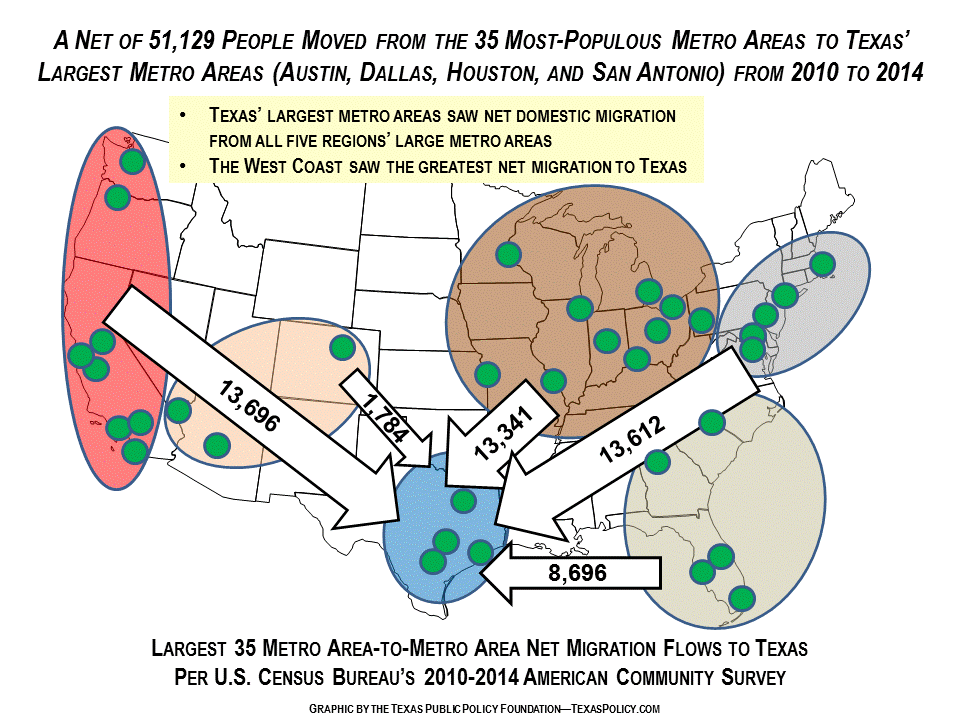This commentary originally appeared in Forbes on March 20, 2017.
People move for many reasons: a new job, to look for work, retirement, or to be close to family. In 2015, the U.S. Census Bureau estimated that 46.8 million people moved. Some 15 percent of the nation moved to a different address than they lived at the year before.
Moving across town is one thing, moving to another state is a far more ambitious undertaking. In 2015, 7.5 million people moved to a different state, 2.4 percent of the population.
Among the four most-populous states, California, Texas, Florida and New York, moving vans and U-Haul were quite busy in 2015.
| State | Move In | Move Out | Net Domestic Migration | Net Foreign Immigration | Total Net Migration |
| California | 514,477 | 643,710 | -129,233 | 142,553 | 13,320 |
| Florida | 584,938 | 445,320 | 139,618 | 118,831 | 258,449 |
| New York | 257,611 | 448,855 | -191,244 | 118,478 | -72,756 |
| Texas | 553,032 | 445,343 | 107,689 | 91,839 | 199,528 |
| Domestic data from Census 2015 American Community Survey 1-Year Estimates, Net Foreign Immigration from Census estimates for July 1, 2015 to July 1, 2016. | |||||
In addition to estimating interstate domestic migration, the Census Bureau also estimates how many people moved between metropolitan areas. The 35 largest metropolitan areas display migration patterns that reflect the economic dynamism of their regions.
After assigning each of the 35 major urban areas to six geographic regions, the Atlantic Northeast, the Atlantic Southeast, the Rust Belt and Midwest, Texas, the Mountain West, and the Pacific Coast, one trend becomes clear: Texas’ major cities are attracting Americans from every region.
Of the 35 largest metro areas in America, a net of 51,129 people moved from the 31 largest metro areas outside of Texas to Austin, Dallas, Houston and San Antonio from 2010 to 2014. Net migration was the highest out of three regions into Texas: Atlantic Northeast, the Rust Belt and Midwest, and the Pacific Coast, with each region’s big metros sending a net of more than 13,000 people to live in Texas’ four largest metro areas.

A Net of 51,129 People Moved from the 35 Most-Populous Metro Areas to Texas’ Largest Metro Areas (Austin, Dallas, Houston, and San Antonio) from 2010 to 2014
Austin, Texas, host of the recently concluded South by Southwest Conference & Festivals, is known for good barbecue and high-tech manufacturing. The Census estimates that the greatest net migration to Austin from outside of Texas came from the Los Angeles area, followed closely by New York. San Francisco Phoenix, Miami, Chicago, Tampa, Orlando, Detroit and Washington, D.C. round out the top ten (although the margin of error for Washington was outside of the estimated gain, so Austin might have lost population to D.C.).
| Metro Area | Net Migration to Austin-Round Rock Metro, 2010-2014 Estimate |
| Los Angeles-Long Beach-Anaheim, CA Metro Area | 1,273 |
| New York-Newark-Jersey City, NY-NJ-PA Metro Area | 1,135 |
| San Francisco-Oakland-Hayward, CA Metro Area | 744 |
| Phoenix-Mesa-Scottsdale, AZ Metro Area | 691 |
| Miami-Fort Lauderdale-West Palm Beach, FL Metro Area | 687 |
| Chicago-Naperville-Elgin, IL-IN-WI Metro Area | 615 |
| Tampa-St. Petersburg-Clearwater, FL Metro Area | 603 |
| Orlando-Kissimmee-Sanford, FL Metro Area | 595 |
| Detroit-Warren-Dearborn, MI Metro Area | 470 |
| Washington-Arlington-Alexandria, DC-VA-MD-WV Metro Area | 387 |
Census calculates that the Austin area lost population to five metro areas outside of Texas, led by the high-tech Seattle-Tacoma-Bellevue area followed by Boston-Cambridge-Newton, but all five of those estimates are within Census’ margin of error.
To continue to attract entrepreneurs and workers from all across America, Texas policymakers need to build on the Lone Star State’s competitive advantages in taxation—the Tax Foundation puts Texas’ state and local tax burden as the 46th-lowest in the nation—and light and predictable regulation.
In addition, efforts to push back against the state’s powerful trial bar lobby need to redouble. In 2003, before major medical malpractice reforms, the U.S. Chamber of Commerce ranked Texas as having the 46th-worst lawsuit climate, just behind rival California. By 2010, reforms had propelled Texas up to 36th, statistically very close to the national average. However, by 2015, the Chamber’s Institute for Legal Reform’s latest ranking had Texas slipping to 40th.
Lastly, Texas legislators need to guard against aggressive efforts by Texas cities to undercut Texas’ regulatory and taxation advantage. Proliferating municipal restrictions on property rights, occupational licensure, and the sharing economy (ask SXSW attendees what they thought about the absence of Uber and Lyft in Austin), as well as rapidly growing property tax revenues threaten Texas’ robust economic growth. Gov. Greg Abbott thought the danger acute enough that he warned in 2015 of “…a patchwork quilt of bans and rules and regulations that is eroding the Texas model” leading to the California-ization of Texas.
Should Texas’ elected representatives strengthen the Texas model, vanity plates like this one seen recently on the streets of Austin will likely proliferate.
